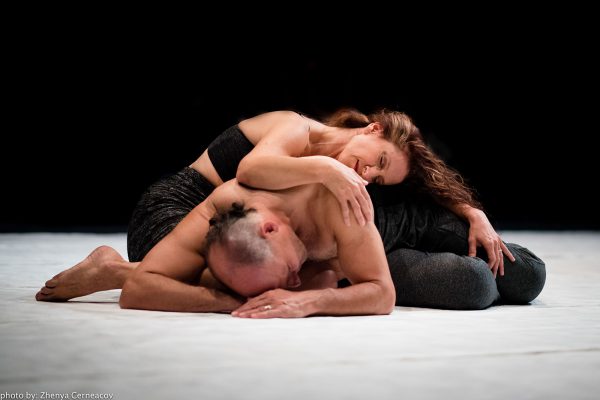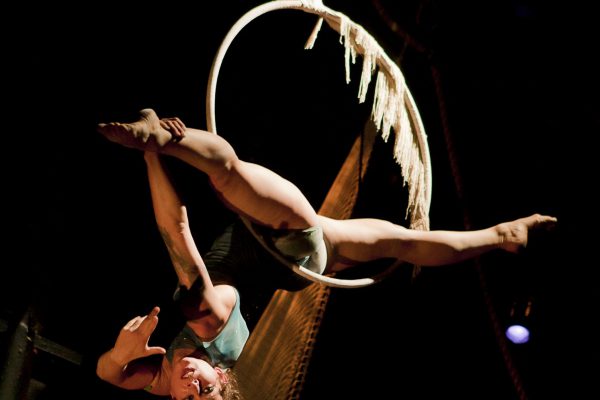With total darkness comes the familiar growing discomfort that creeps in during the sudden absence of light, as my eyes try to adjust to the surrounding nothingness. Then — light. One single lamp atop a desk, barely illuminating one side of the face of a woman who is seated at the small, rectangular kitchen table. The few household objects on the table — a box of cereal, a piece of fruit, a picture frame — are overlooked as the woman’s worry-stricken expression immediately grasps your attention. Just as you begin to ponder the cause of this woman’s anxiety, the light is abruptly shut off and you’re in total darkness again. Then another flicker of light — then dark … It goes on like this, like a curious child playing with a light switch.
As the intervals of darkness grow shorter, flashes of scenes onstage are more difficult to catch as your eyes try to adjust to the constantly changing light. Did the logo on the cereal box change? Has the picture frame moved? I’m reminded of one of my favourite childhood games — can you spot the difference? Each flicker of light presents a new version of an effortlessly flawless tableau with the dancer in complete stillness, as I try to resolve whether she is even real.
This is the work Habiter, choreographed by Katia-Marie Germain and danced by Marie-Gabrielle Ménard and Germain — the first work of two in the Matjash Mrozewski series from the 2019 dance: made in canada Festival. It’s a work that stuns by creating illusion. This excerpt from the longer work grounds itself in the mundane of the everyday but keeps audiences second-guessing with every seamless stage change. Many of these changes break long unsettling moments, supported by the constant pulsing of the mechanical-sounding repeating music. Moments of stillness are instantly broken by abrupt occurrences, like the drop of a spoon. The spoon, precariously balanced in the dancer’s hands, would inevitability drop, but that didn’t diminish its ability to make me jump in my seat. Similarly, minute actions break the hypnosis of Habiter.
But perhaps the most gripping moments came midway through, when both Ménard and Germain were onstage, one moving as a shadow of the other. And between the tableau-esque moments of stillness, the dancers broke into robotic pulses, moving in smooth yet mechanically driven choreography. The pair’s uncanny synchronicity, in the simplest of actions like swiping their forearm across the table, were timed with the utmost precision, challenging the idea that perfection does not exist.
While the blackout pauses between scenes could sometimes last longer than expected and proved to be a bit hard on the eyes, which have to constantly readjust to the light and dark of the space between the flickers, it all proved to add to the experience of defying the familiar: what we see and remember may not always represent reliability.
In the second half of the series, Company 605’s co-artistic director Josh Martin shared an excerpt of Leftovers, an investigational piece exploring the relationship, or perhaps lack of, between mind and body in recounting past events, including trauma. Martin’s piece jolts audiences from the start, with a forceful piece of music contrasting its predecessor. It isn’t the music that keeps my attention; it is Martin’s bewildering and distinct movement quality. It’s his staccato attitude, his absurd ability to move each of his body parts from his head to each finger and toe with such confident precision that wins me over.
While Martin’s choreography imitates the everyday — walking, falling, sleeping — each movement is clearly identifiable as both intended and needed. There’s intention behind each march, every wriggle. And while Martin is committed to each movement from the start, his dancing only grows bigger as the piece progresses, Martin is fully aware, and more importantly in control, of his body’s capabilities. He knows how to make effort look effortless.
There’s an interesting contradiction in movement throughout Martin’s excerpt, by which repertoire near the beginning is reminiscent of routine, daily actions — floor choreography that could be a sleeping pattern played in fast-forward. Yet, by the end of the piece, he’s a master of disguise, contorting his body to appear inhuman or alien; an unaccounted-for hand protrudes from his back at one point. The struggle of Martin’s performance — the constant push and pull — brings forward question of mind-body duality: does the body truly have a mind of its own? When your body no longer obeys your mind, how do you make it do what you want?
~
Did you enjoy this article? Subscribing to The Dance Current helps support bold and inclusive coverage of dance in Canada.
Tagged: Contemporary, All





